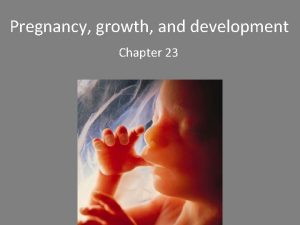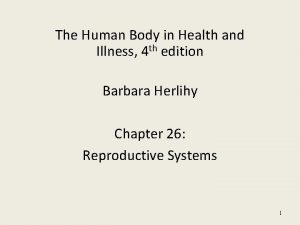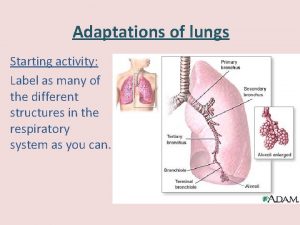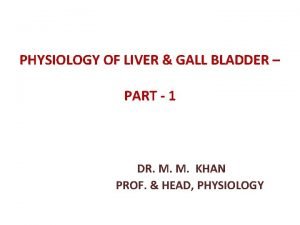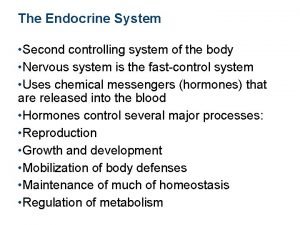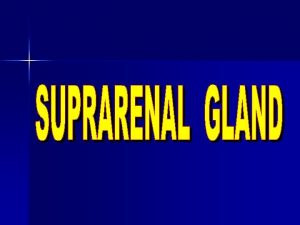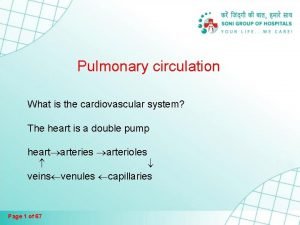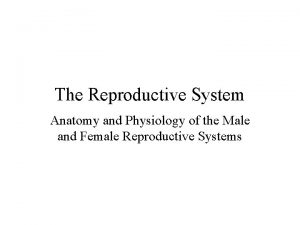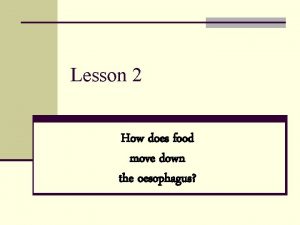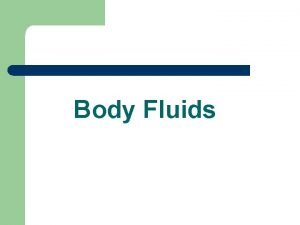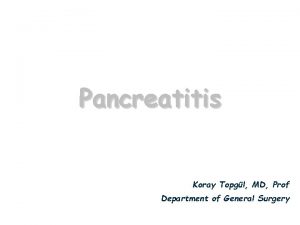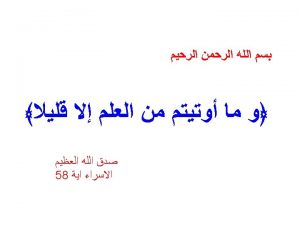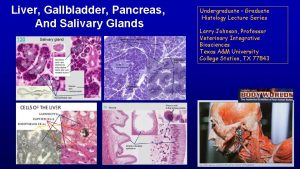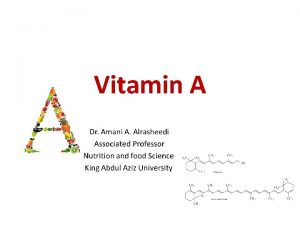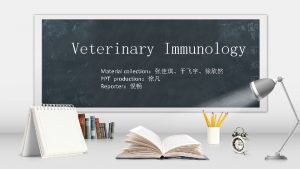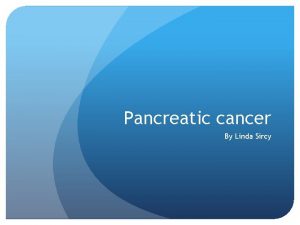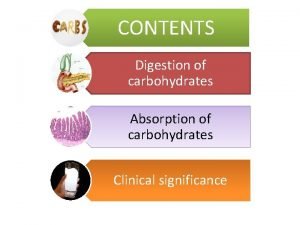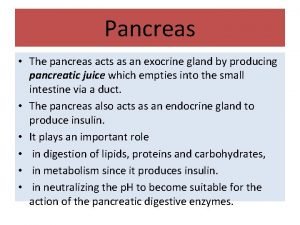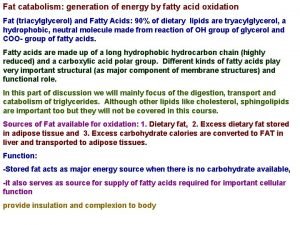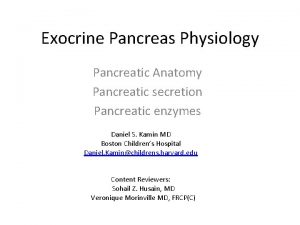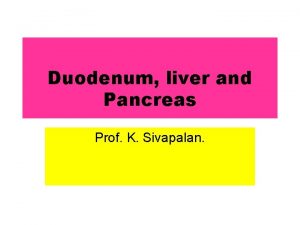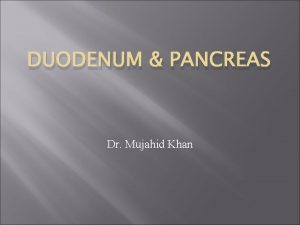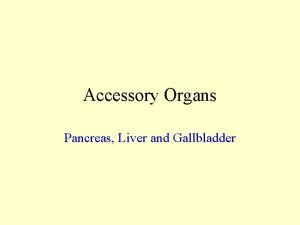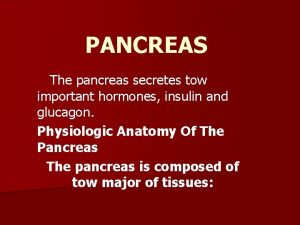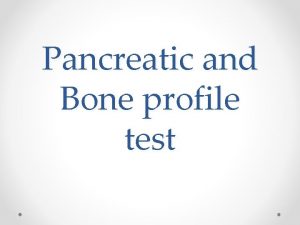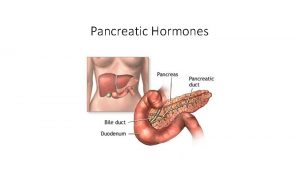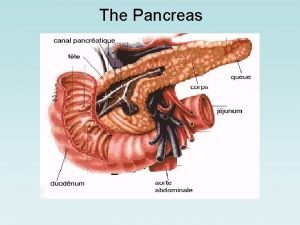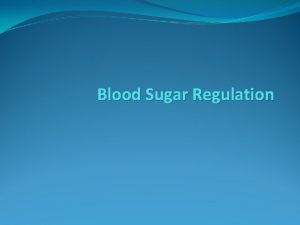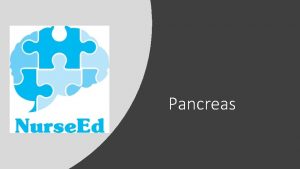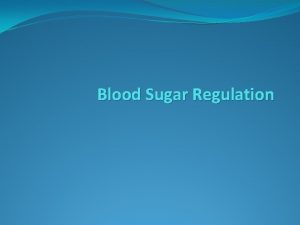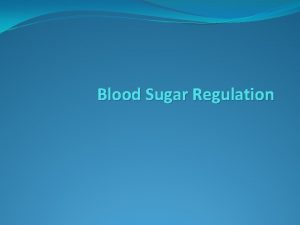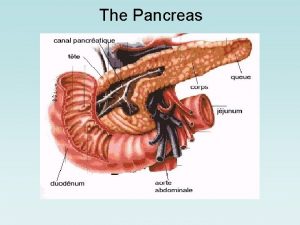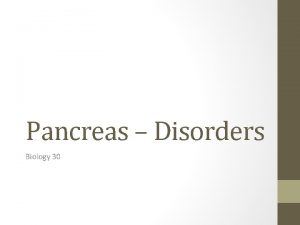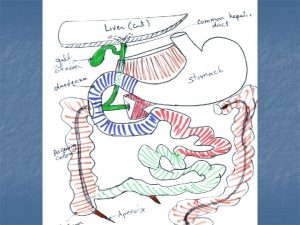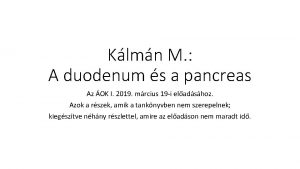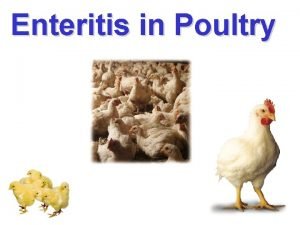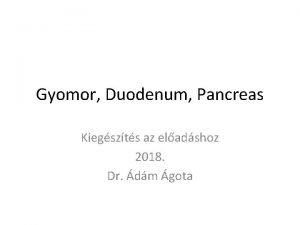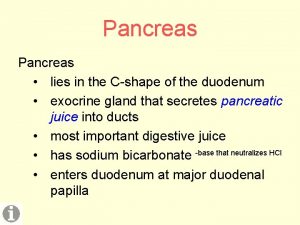Pancreas Secretes pancreatic fluid into the duodenum Contains






























- Slides: 30

. Pancreas • Secretes pancreatic fluid into the duodenum • Contains digestive enzymes: Trypsin & Chymotrypsin (“proteases”), Amylase (carbohydrase), Lipase, Nucleases • Contains bicarbonate to neutralize the stomach acid • The pancreas also secretes the hormones insulin & glucagon to regulate sugar metabolism p. 223

The Pancreas

Lipid Digestion • Broken down by lipases from the pancreas • Fat must be emulsified by bile salts so that its surface area increases for pancreatic lipases Lipases + lipid glycerol + fatty acids

Nucleic Acid Digestion • Digested by nucleases released by the pancreas & embedded in the small intestine 1. Nucleases (pancreas) + nucleic acid nucleotides 2. Nucleosidases (small intestine) + nucleotides bases, sugars, phosphates p. 211

5. Liver • Largest internal organ (~football-sized) • Secretes bile (greenish-yellow liquid) • works like a detergent to emulsify water-insoluble lipids into a fine suspension, allowing the lipases to reach the lipids for digestion p. 223

Cirrhosis • Inflammation of the liver causes scar tissue to replace normal liver tissue • Caused by chronic alcoholism and hepatitis, & overuse of some drugs • Often develops after fatty liver (replacement of normal liver tissue with fat) from alcoholism or obesity Normal fatty cirrhosis http: //commons. wikimedia. org/wiki/Category: Histopathology_of_fatty_liver#mediaviewer/File: Non-alcoholic_fatty_liver_disease 1. jpg

6. Gall Bladder • Small green sack under liver • Bile is made in the liver but stored in the gall bladder • When chyme enters the duodenum, it causes the gall bladder to squeeze bile through a duct into the duodenum p. 223

Gall Stones • Formed when cholesterol in bile forms crystals, which grow into gall stones. • Genetic susceptibility, also caused by alcoholism & obesity • Treatment: ultrasound shock waves to break up stones, diet changes (small meals, more omega-3 fatty acids), & gall bladder removal http: //commons. wikimedia. org/wiki/Category: Gallstones#mediaviewer/File: Gallstones. jpg

7. Small Intestine • Final site of chemical digestion & most nutrient absorption • Made up of ridges (hills & valleys) called villi • Each villus has thousands of microscopic ridges called microvilli connected to capillaries • huge surface area for nutrient absorption

p. 222

7. Small intestine (Not very small!!! ~7 long) 1. Duodenum: • First 25 cm of the small intestine • Where ducts from the gall bladder & pancreas join 2. Jejunum: ~2. 5 m long • • Contains most folds & glands Chemical digestion 3. Ileum: ~3 m long • Major site of nutrient absorption http: //commons. wikimedia. org/wiki/Small_intestine#mediaviewer/File: Stomach_colon_rectum_diagram. svg

Structure of the Small Intestine

Small Intestine • Food entering the small intestine is called? • In order to be further digested – what do we need in the small intestine?

Nutrient Absorption • Carbohydrates absorbed as simple sugars (glucose) • Proteins absorbed as amino acids • Nucleic acids absorbed as sugars, bases, & phosphates • Lipids absorbed as fatty acids & glycerol

Protein Digestion in Small Intestine • Where does protein digestion begin? • Two proteases secreted by the pancreas that aid in the digestions of protein in the small intestine, trypsin and chymotryspin become activated in the intestine when they come in contact with another enzyme. • They bind on to specific peptide bonds and hydrolyze them into shorter peptide chains • Can they be absorbed into the villi yet? • No. . Still too big

Protein digestion cont…. • These small peptide chains are broken down further by other protease enzymes. They are hydrolyzed into AMINO ACIDS. • The amino acids are able to be absorbed into the villi of the small intestine, by active transport. • The amino acids are then carried to the liver, where they are stored. They can carry out a variety of functions when needed by the body, including making proteins for cellular structures.

Proteins Polypeptides Short Polypeptides Amino Acids


http: //www. mcgrawhill. ca/secondary/illustrati ons/books/Inquiry_into_Biology/full/unit_04/c hapter_06/F 6_23. jpg hapter_066_23

Nutrient Absorption: Carbohydrates, Proteins & Nucleic Acids • Simple sugars & amino acids absorbed by active transport (using ATP) into microvilli capillaries leading directly to the liver • Some sugars are retained in the liver and stored as glycogen • From the liver, sugars are released into the bloodstream

Carbs in Duodenum Pancreas Secretes Amylase starch disaccharides monosaccharides Monosaccharides absorbed into blood stream

Carbohydrate Absorption Monosaccharides are absorbed villi When our blood sugar levels drop, glycogen is converted back into glucose and delivered to the cells monosaccharides go to the liver Glucose converted and stored as glycogen


Fat Digestion and Absorption • Is there any digestion of fat in the mouth or stomach? • Arrival of fat in the duodenum stimulates the secretion of bile. The bile separates the fat droplets. This is not chemical digestion – only physical. • Lipase – the enzyme which aids in the digestion of fats, binds to the glycerol and fatty acid molecules • Through hydrolysis, these molecules separate.

Nutrient Absorption: Fats • Glycerol & fatty acids taken up into cells lining the small intestine & are put back together into triglycerides • Triglycerides then packaged with cholesterol & proteins into chylomicrons • Chylomicrons are absorbed into the LYMPH (not the bloodstream) • They do NOT travel to the liver; instead move out of large lymph vessels into veins in the neck to the heart

Fats…. • The glycerol and free fatty acid absorb into the cells of the villi by diffusion. Fat inhave the • Once they passed through into the villi, they Form reform into back into duodenum Lipase –binds to The glycerol triglyceride molecules. They are taken by the lymph fat vessels droplets. in the villi. stimulates the fat droplets and fatty acid • secretion of bile. and breaks them They are taken absorb into The bile down into by the lymph the cells of separates the fat As we know, the lymph vessels intointhe glycerol and move their contents vessels the droplets. the villi by fattyglycerol acids bloodstream, where the anddiffusion. the free fatty acids villi. are available Physical to be used by our cells – or clog our arteries. digestion


Quick review • What is the smallest unit of carbs and how are they transported across the intestinal wall? • Where is the enzyme trypsin secreted from and what macromolecule does it digest? • Where is bile produced? Where is it stored? What does it do?

Summary: Digestion of Nutrients

Confusion Check-In • What would be the impact on the digestive system if mechanical digestion did not take place? (p. 231) • What are two reasons why most of the digestive enzymes are secreted into the small intestine instead of the stomach? (p. 231) • How is surface area (SA) maximized in the small intestine? Why is SA important? (p. 223) • How do the pancreas, liver, and gall bladder aid digestion? (p. 224)
 Secretes estrogens and progesterone
Secretes estrogens and progesterone Birth canal is formed
Birth canal is formed Bronchus transverse section
Bronchus transverse section Choleretics
Choleretics Corpus luteum secretes
Corpus luteum secretes What secretes hormones
What secretes hormones Pineal gland secretes
Pineal gland secretes Subclavian lymph trunk
Subclavian lymph trunk Corpus luteum secretes
Corpus luteum secretes A muscular bag secretes gastric juice
A muscular bag secretes gastric juice Extracellular fluid contains
Extracellular fluid contains Fluid statics deals with fluid at rest
Fluid statics deals with fluid at rest Timeline in fluid mechanics
Timeline in fluid mechanics Fluid statics deals with
Fluid statics deals with Movement of body fluids
Movement of body fluids Intracellular extracellular fluid
Intracellular extracellular fluid Transcellular fluid
Transcellular fluid Shifting dullness and fluid thrill
Shifting dullness and fluid thrill Is synovial fluid extracellular fluid
Is synovial fluid extracellular fluid Interstitial fluid vs extracellular fluid
Interstitial fluid vs extracellular fluid Cck function in digestion
Cck function in digestion Pancreatitis score
Pancreatitis score The main jobs of the large intestine are _____.
The main jobs of the large intestine are _____. Git hormones
Git hormones Histology
Histology Vitamin a functions
Vitamin a functions Ralph steinman pancreatic cancer
Ralph steinman pancreatic cancer Stage 2b pancreatic cancer
Stage 2b pancreatic cancer Action of pancreatic amylase
Action of pancreatic amylase Is bile in pancreatic juice
Is bile in pancreatic juice Pancreatic enzymes
Pancreatic enzymes
